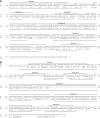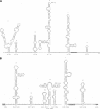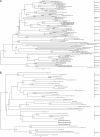Natural occurrence and characterization of two internal ribosome entry site elements in a novel virus, canine picodicistrovirus, in the picornavirus-like superfamily
- PMID: 22205729
- PMCID: PMC3302267
- DOI: 10.1128/JVI.05481-11
Natural occurrence and characterization of two internal ribosome entry site elements in a novel virus, canine picodicistrovirus, in the picornavirus-like superfamily
Abstract
Dicistroviridae and Picornaviridae are two phylogenetically related families of positive-sense single-stranded RNA viruses in the picornavirus-like superfamily with similar gene contents but different genome organizations and hosts. In a surveillance study involving 1,472 samples from 368 dogs over a 22-month period, we identified a novel picornavirus-like virus from 47 fecal and urine samples by the use of reverse transcription-PCR (RT-PCR). Sequencing and phylogenetic analysis of three complete genomes revealed that, although it seemed that the virus was most closely related to other picornaviruses, P1, P2, and P3 of the virus possessed very low amino acid identities of <30% to those of all other known picornaviruses and that the amino acid identities between the 3D(pol) and 2C of the virus and the RNA-dependent RNA polymerases and helicases of all other picornaviruses were <35%. Distinct from other picornaviruses, the genomes of the virus contain two putative internal ribosome entry sites (IRESs) and two open reading frames, encoding two polyprotein precursors (844 and 1,406 amino acids), separated by an intergenic region (IGR) of 588 bases. A dual-luciferase activity assay using DNA and RNA transfection revealed that both IRESs were functional. Quantitative RT-PCR showed that numbers of viral RNAs ranged from 7.55 × 10(6) to 1.26 × 10(9) copies/ml of urine and 1.82 × 10(6) to 4.97 × 10(10) copies/ml of fecal sample. This is the first report of the natural occurrence of two functional IRESs in nondicistroviruses. Based on our results, we have proposed a novel species, canine picodicistrovirus (CPDV), to describe this novel member of the picornavirus-like superfamily, which could represent a novel family of viruses.
Figures








Similar articles
-
Identification and genetic characterization of a novel picornavirus from chickens.J Gen Virol. 2014 May;95(Pt 5):1094-1103. doi: 10.1099/vir.0.061085-0. Epub 2014 Feb 4. J Gen Virol. 2014. PMID: 24496829
-
A distinct group of hepacivirus/pestivirus-like internal ribosomal entry sites in members of diverse picornavirus genera: evidence for modular exchange of functional noncoding RNA elements by recombination.J Virol. 2007 Jun;81(11):5850-63. doi: 10.1128/JVI.02403-06. Epub 2007 Mar 28. J Virol. 2007. PMID: 17392358 Free PMC article.
-
Complete genome sequence analysis of Seneca Valley virus-001, a novel oncolytic picornavirus.J Gen Virol. 2008 May;89(Pt 5):1265-1275. doi: 10.1099/vir.0.83570-0. J Gen Virol. 2008. PMID: 18420805
-
Advances and Breakthroughs in IRES-Directed Translation and Replication of Picornaviruses.mBio. 2023 Apr 25;14(2):e0035823. doi: 10.1128/mbio.00358-23. Epub 2023 Mar 20. mBio. 2023. PMID: 36939331 Free PMC article. Review.
-
Functional analysis of structural motifs in dicistroviruses.Virus Res. 2009 Feb;139(2):137-47. doi: 10.1016/j.virusres.2008.06.006. Epub 2008 Jul 25. Virus Res. 2009. PMID: 18621089 Review.
Cited by
-
Equine rhinitis B viruses in horse fecal samples from the Middle East.Virol J. 2016 Jun 7;13:94. doi: 10.1186/s12985-016-0547-x. Virol J. 2016. PMID: 27267372 Free PMC article.
-
Initiation on the divergent Type I cadicivirus IRES: factor requirements and interactions with the translation apparatus.Nucleic Acids Res. 2016 Apr 20;44(7):3390-407. doi: 10.1093/nar/gkw074. Epub 2016 Feb 11. Nucleic Acids Res. 2016. PMID: 26873921 Free PMC article.
-
A decade of RNA virus metagenomics is (not) enough.Virus Res. 2018 Jan 15;244:218-229. doi: 10.1016/j.virusres.2017.10.014. Epub 2017 Oct 18. Virus Res. 2018. PMID: 29055712 Free PMC article. Review.
-
An Emerging Duck Egg-Reducing Syndrome Caused by a Novel Picornavirus Containing Seven Putative 2A Peptides.Viruses. 2022 Apr 29;14(5):932. doi: 10.3390/v14050932. Viruses. 2022. PMID: 35632674 Free PMC article.
-
Identification and Genome Characterization of the First Sicinivirus Isolate from Chickens in Mainland China by Using Viral Metagenomics.PLoS One. 2015 Oct 13;10(10):e0139668. doi: 10.1371/journal.pone.0139668. eCollection 2015. PLoS One. 2015. PMID: 26461027 Free PMC article.
References
-
- Anisimova M, Gascuel O. 2006. Approximate likelihood-ratio test for branches: a fast, accurate, and powerful alternative. Syst. Biol. 55:539–552 - PubMed
-
- Belsham GJ. 2009. Divergent picornavirus IRES elements. Virus Res. 139:183–192 - PubMed
-
- Bonning BC, Miller WA. 2010. Dicistroviruses. Annu. Rev. Entomol. 55:129–150 - PubMed
Publication types
MeSH terms
Substances
Associated data
- Actions
- Actions
- Actions
LinkOut - more resources
Full Text Sources

